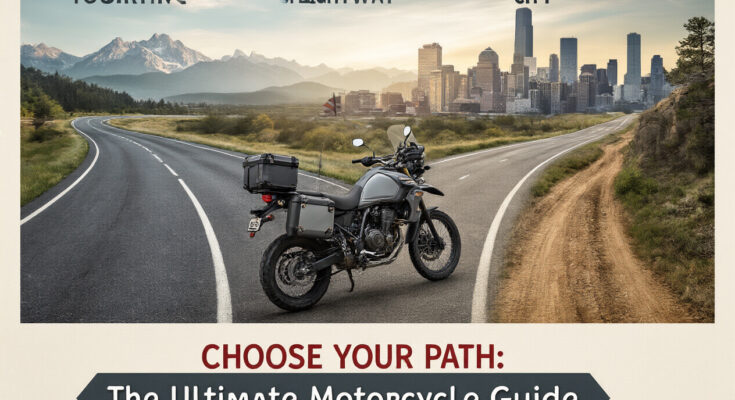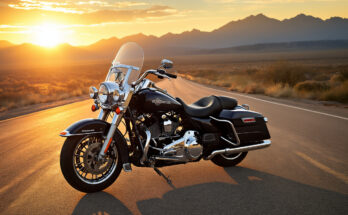Ever noticed how motorcycle riders can’t stop smiling, no matter the weather? That’s because they’ve found something most people never will – the perfect blend of freedom, practicality, and adventure on two wheels.
Choosing the right motorcycle for touring, city, and off-road rides in the USA isn’t just about engine size or brand loyalty. It’s about matching your riding personality with a machine that feels like an extension of yourself.
Whether you’re daydreaming about cross-country highways, navigating urban jungles, or kicking up dirt on backcountry trails, this guide will save you thousands in potential regrets and countless hours of research.
But here’s the thing about motorcycles that most salespeople won’t tell you…
Understanding Different Types of Motorcycle Riding

A. Touring: What Makes Long-Distance Riding Unique
Ever watched riders cruise down endless highways with bikes packed like they’re moving houses? That’s touring – the marathon of motorcycling.
Touring isn’t just riding far; it’s living on your bike. You need comfort that lasts hours, not minutes. Those big windscreens and cushy seats aren’t just for show – they’re sanity savers at mile marker 300.
The bikes built for this mission are different beasts. Think Honda Gold Wings or Harley-Davidson Road Glides – essentially two-wheeled RVs with plush seats, weather protection, and enough storage to pack for weeks. They’re heavy, sure, but that stability feels like a blessing when crosswinds hit on mountain passes.
Long-distance riding demands different skills too. You’ll become obsessed with fuel range, weather patterns, and finding diners with good coffee and parking lots you can see from inside.
B. City Commuting: Navigating Urban Challenges
City riding is basically motorcycle parkour. You’re constantly dodging opening car doors, spotting potholes, and finding gaps in traffic that cars can’t use.
Urban environments demand nimble, responsive bikes. Heavy cruisers that shine on highways can feel like steering battleships through downtown traffic. That’s why you see so many naked standards and small-displacement sport bikes weaving through cities.
The perfect city bike needs quick steering, good brakes, and an upright position that lets you scan for threats constantly. Fuel efficiency matters when you’re stop-and-go all day, and lighter weight makes those unexpected U-turns way easier.
C. Off-Road Adventures: Tackling America’s Diverse Terrain
Off-road riding is where you learn motorcycles can go places that defy logic. From Arizona’s desert trails to muddy Pacific Northwest forests, America offers endless unpaved playgrounds.
This style demands specialized machines. Dirt bikes and adventure motorcycles come with long-travel suspension, aggressive tires, and ground clearance that would make street bikes jealous. They’re designed to absorb punishment that would break normal bikes in minutes.
The skills here are totally different. You’ll stand on pegs more than sit, use body English to control slides, and learn that sometimes throttle is the answer to problems that seem counterintuitive.
D. Combination Riding: Finding the Perfect Balance
Most riders don’t fit perfectly into just one category. You might commute weekdays but escape to country roads on weekends.
This is where versatile bikes shine. Adventure motorcycles like the BMW GS series or Triumph Tiger have exploded in popularity because they handle multiple riding styles reasonably well. They’re tall enough for dirt, comfortable enough for distance, and manageable enough for cities.
The secret to combination riding is honest self-assessment. Which style will be your primary focus? Would you rather have a bike that excels at one thing and struggles elsewhere, or something that does everything decently? Your truthful answer determines your perfect match.
Key Factors to Consider When Choosing Your Motorcycle
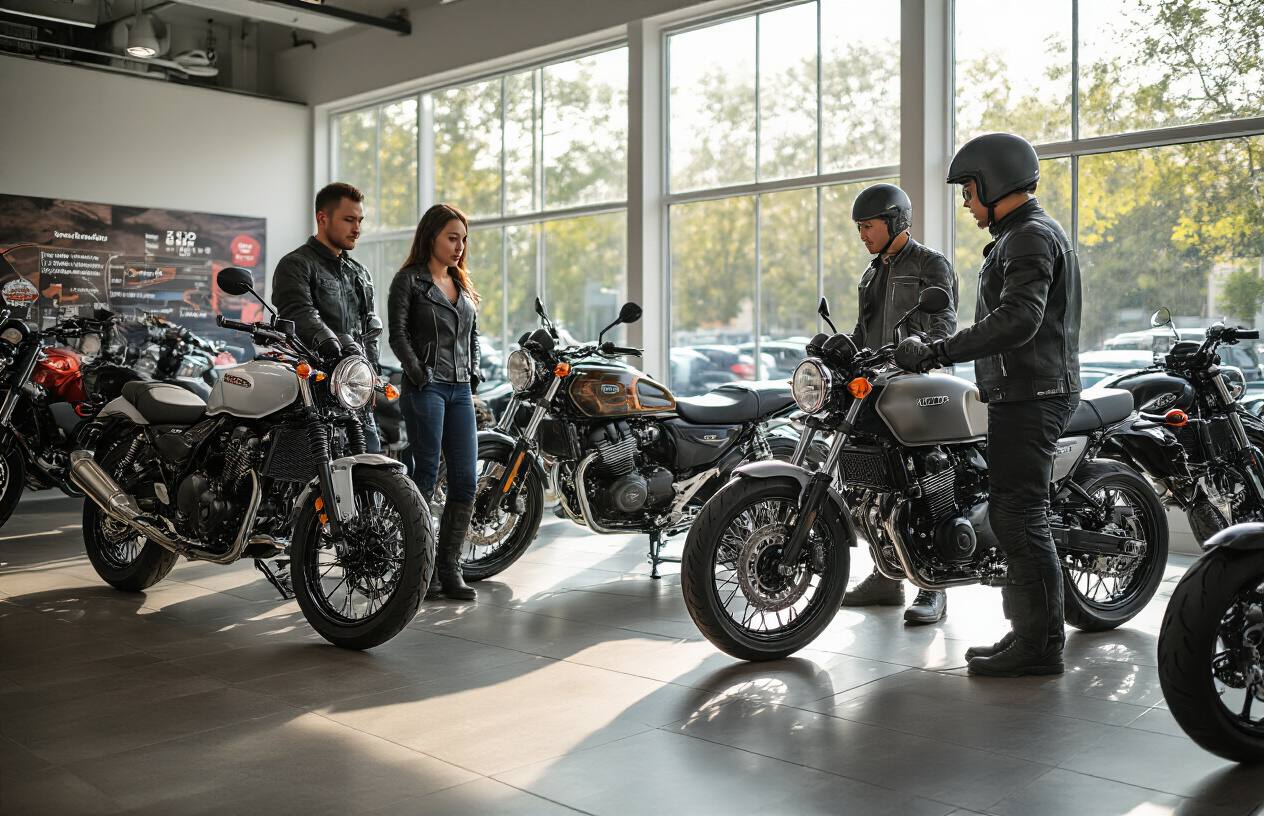
A. Budget: Getting the Best Value for Your Investment
Motorcycles come in all price ranges, from $5,000 budget-friendly models to $30,000+ premium machines. But here’s the thing—expensive doesn’t always mean better for you.
First-time buyers: stick to the $5,000-$8,000 range. You’ll get a reliable bike without the heart attack when you drop it (and you probably will).
For touring, expect to pay more—good luggage capacity and comfort features drive up costs. A solid touring bike starts around $12,000, but you’ll thank yourself on day three of that cross-country trip.
City riders can get away with less. A nimble commuter in the $6,000-$9,000 range will handle everything from traffic jams to grocery runs.
Off-road enthusiasts face a trade-off: cheaper bikes mean more repair costs after rough riding. Budget at least $8,000 for something that won’t fall apart on the trail.
Don’t forget the extras:
- Gear: $800-$1,500 for quality helmet, jacket, gloves, boots
- Insurance: $500-$1,200 annually (higher for sport bikes)
- Maintenance: $500-$1,000 yearly
The sweet spot? Three-year-old bikes with low mileage. You’ll dodge the worst depreciation hit while getting modern features.
B. Experience Level: Matching Power to Your Skills
Buying too much motorcycle is like giving a teenager a Ferrari—exciting but potentially disastrous.
Beginners should aim for:
- 300-500cc for sport/street bikes
- 650-750cc for cruisers (they’re less twitchy)
- 250-400cc for dirt bikes
These numbers aren’t random. Smaller engines are more forgiving when you make mistakes, and you will make mistakes.
Intermediate riders (2+ years in the saddle) can comfortably handle:
- 600-800cc sport bikes
- 900-1200cc cruisers
- 450-650cc dual sports
Veterans with 5+ years of riding can pretty much handle whatever catches their eye, but even pros respect the power of a 1000cc+ sportbike.
The progression matters. I’ve seen too many overconfident beginners on liter bikes who either scared themselves straight or ended up as statistics.
Your skills need to grow with your engine size. Nothing ruins confidence faster than a bike that’s constantly trying to kill you.
C. Physical Dimensions: Finding the Right Fit for Your Body
That gorgeous bike in the showroom? Worthless if you can’t touch the ground.
Seat height is crucial—your feet should reach the ground with at least the balls of your feet flat at stops. For shorter riders (under 5’8″), look for bikes with 30″ or lower seat heights.
Weight matters more than you think. A 600-pound touring bike feels like a mountain when you’re trying to back it out of a parking spot. New riders should stick to bikes under 400 pounds until handling skills develop.
Reach to the handlebars shouldn’t strain your shoulders or lock your elbows. Your arms should have a slight bend when seated normally.
Riding position affects comfort on long trips:
- Cruisers: feet forward, upright back (comfortable but less control)
- Sport bikes: leaned forward, feet back (more control but strains wrists/back)
- Adventure/touring: upright, neutral foot position (best all-day comfort)
Try this test: sit on the bike for 20 minutes in the showroom. If you’re uncomfortable there, imagine how you’ll feel after 200 miles.
D. Maintenance Requirements: Understanding Long-Term Costs
Some bikes are money pits disguised as transportation. Others will outlive you.
Japanese bikes (Honda, Yamaha, Kawasaki, Suzuki) typically need less maintenance and have cheaper parts. European brands offer prestige and performance but at premium maintenance costs.
Chain drive needs attention every 500-700 miles. Shaft drive (common on touring bikes) costs more upfront but requires less regular maintenance.
Air-cooled engines are simpler to maintain but liquid-cooled ones run more consistently in varying weather.
Valve adjustment intervals matter:
- 4,000 miles: you’ll be at the shop often
- 15,000+ miles: much more wallet-friendly
Modern fuel-injected bikes start more reliably but carbureted models are simpler for DIY mechanics.
Consider these annual costs:
- Oil changes: $50-150 each (DIY vs. shop)
- Tires: $300-600 per set
- Chain/sprockets: $200-350 every 15,000-25,000 miles
The most overlooked cost? Specialized tools. Budget $300-500 if you plan to do your own work.
E. Storage Needs: Carrying Capacity for Different Riding Styles
Nothing kills the motorcycle dream faster than realizing you can’t carry what you need.
Touring riders need serious storage—at least 35+ liters of capacity. Hard panniers offer security but add width. Soft bags are lighter but vulnerable to weather and theft.
City commuters should look for:
- Under-seat storage for small items
- Tank bags for quick access to phone/wallet
- Topcase options for grocery runs or gym bags
Off-road enthusiasts face a challenge: more storage means more weight, which affects handling on technical terrain. Modular systems let you add/remove capacity based on the trip.
Consider these practical questions:
- Do you need to carry a laptop?
- Will you be shopping with this bike?
- Overnight trips require at least 30L capacity
- Multi-day adventures need 60L+
The best storage solutions are waterproof, lockable, and don’t affect handling when loaded. And remember—just because a manufacturer says a bag fits doesn’t mean it fits well. Check owner forums for real-world experiences.
Best Touring Motorcycles for American Roads
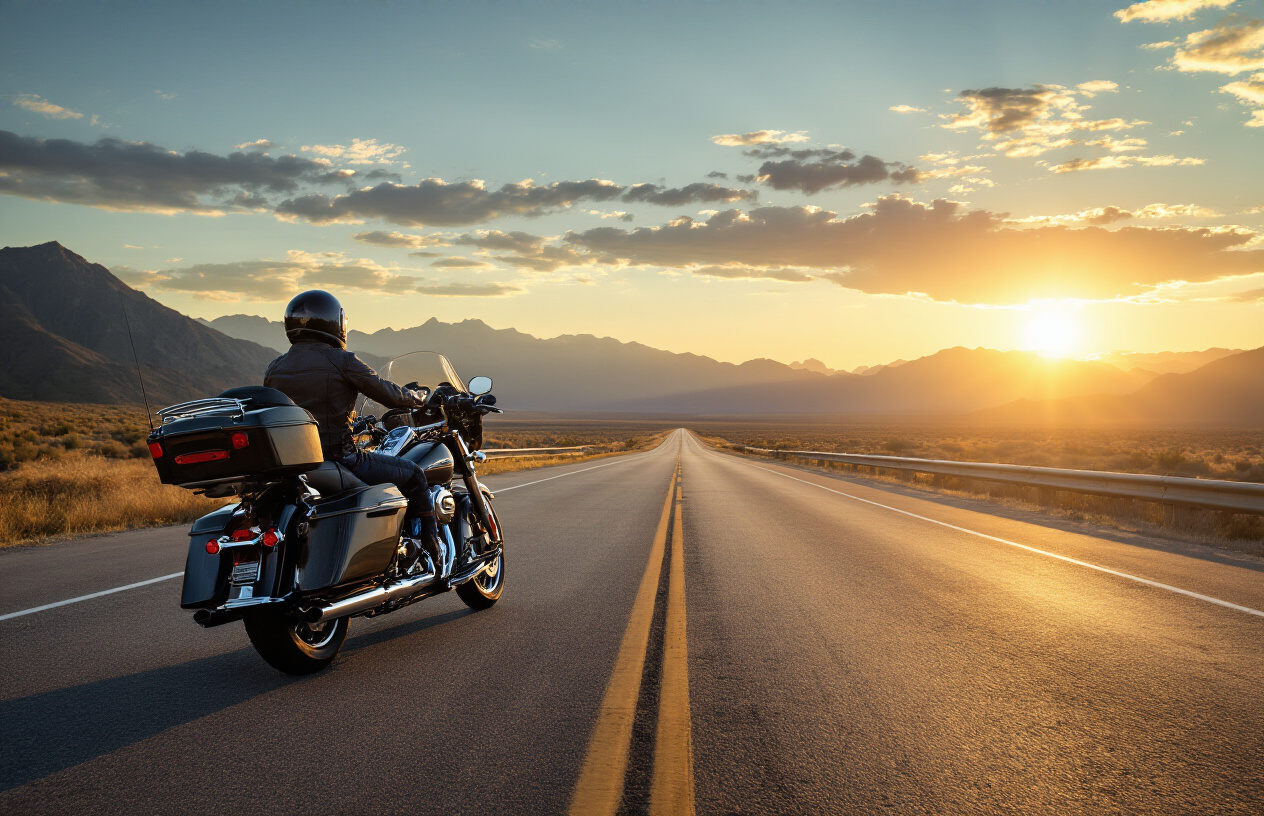
A. Full-Dress Touring Bikes: Ultimate Comfort for Cross-Country Trips
You know those motorcycles that look like they’ve got everything but the kitchen sink attached? That’s a full-dress tourer for you. Bikes like the Harley-Davidson Ultra Limited and Indian Roadmaster aren’t just transportation—they’re rolling living rooms.
These babies come packed with windshields taller than some cars, seats that feel like your favorite recliner, and enough storage to pack for a month. The stereo systems? Better than what I’ve got in my apartment.
The Honda Gold Wing takes this comfort game to another level with its car-like features—automatic transmission, airbags, and even Apple CarPlay. Ridiculous, right? But when you’re grinding out 500 miles a day, you’ll thank the motorcycle gods for every comfort.
Just remember—these comfort champions come with a weight penalty. Most tip the scales north of 800 pounds, which you’ll definitely feel when navigating parking lots or tight spaces.
B. Sport Tourers: Balancing Performance with Long-Distance Capability
Not everyone wants to feel like they’re riding their living room couch across America. Sport tourers hit that sweet spot where you can carve canyons one day and cross state lines the next.
The BMW R1250RT and Yamaha FJR1300 dominate this category for good reason. They’ve got enough power to make you grin inside your helmet but won’t punish your back after three hours in the saddle.
Kawasaki’s Ninja 1000SX deserves serious attention too. It’s basically a sportbike that won’t make you hate life on long rides. The fairings provide decent wind protection without the bulk of a full dresser, and the ergonomics strike that perfect balance between aggressive and all-day comfortable.
The handling on these bikes? Nimble enough to enjoy those twisty mountain roads but stable enough to handle crosswinds on open highways. And most come with hard luggage options that don’t look like ugly afterthoughts.
C. Adventure Tourers: Versatility for Both Highways and Dirt Roads
The Swiss Army knives of the motorcycle world—that’s adventure tourers for you. The BMW R1250GS practically invented this category, and for good reason. These bikes handle everything from smooth interstates to fire roads and everything in between.
What makes them special? Longer suspension travel than road-only bikes, crash protection built right in, and riding positions designed for standing up when the pavement ends. The Triumph Tiger 900 and KTM 1290 Super Adventure bring serious off-road credentials while still being comfortable enough for thousand-mile highway stretches.
Their upright seating position gives you a commanding view of traffic, and those wide handlebars provide leverage for both low-speed maneuvering and off-road control. Plus, most come with spoked wheels that can take a beating when you inevitably hit that pothole you didn’t see.
For exploring America’s vast backcountry roads and national forests, nothing beats these do-it-all machines. Just be prepared for a learning curve if you’re coming from street-only bikes—they’re taller and require different handling techniques.
D. American vs. Foreign Touring Models: Pros and Cons
The age-old debate—American iron or foreign engineering? Harley-Davidson and Indian bring undeniable style and that distinctive rumble that screams “American road trip.” Their low-end torque makes highway cruising effortless, and there’s something special about touring the American landscape on American metal.
| American Tourers | Foreign Tourers |
|---|---|
| Unmatched style and presence | Typically lighter and more nimble |
| Better dealer network across rural USA | Often more advanced technology |
| Simpler maintenance in many cases | Generally better fuel economy |
| Stronger resale value | Usually more performance-oriented |
The foreign contenders from BMW, Honda, and Yamaha often bring more sophisticated technology to the table—better suspension, more rider aids, and sometimes better weather protection. They typically handle better on twisty roads too.
Here’s the bottom line: American bikes connect you with the heritage of road tripping in the USA, while foreign bikes often deliver more performance and features per dollar. Your choice ultimately depends on whether you prioritize that emotional connection or pure riding dynamics.
The perfect touring bike isn’t the most expensive or the most powerful—it’s the one that makes you want to keep riding long after you should have stopped for the day.
Ideal City Motorcycles for Urban American Settings

A. Lightweight Options for Easy Maneuverability
Urban riding demands nimble handling, and that’s where lightweight motorcycles shine. The Honda Grom is basically the go-kart of motorcycles—weighing just 229 pounds, you can flick this thing around like it’s nothing. Perfect for squeezing through those impossibly tight spots in New York or LA traffic.
Kawasaki’s Z400 strikes that sweet spot between power and weight. At 363 pounds, it’s light enough to maneuver through city streets but has enough muscle (45 horsepower) to keep things interesting on weekend rides.
Royal Enfield’s Meteor 350 might surprise you. While not the lightest option, its low center of gravity makes it feel much lighter than its actual weight. Plus, that classic styling gets you noticed at every stoplight.
B. Fuel-Efficient Models for Daily Commuting
Gas prices killing your vibe? The Yamaha MT-03 sips fuel at around 65 mpg while still delivering that satisfying acceleration when the light turns green. Your wallet will thank you after months of daily commuting.
Honda’s PCX150 scooter takes efficiency to another level, easily achieving 100+ mpg in city conditions. Sure, it’s not technically a motorcycle, but when you’re passing gas station after gas station without stopping, who cares about labels?
For something with more presence, the Suzuki SV650 manages an impressive 50 mpg despite its larger engine. It’s proof you don’t need to sacrifice the motorcycle experience for fuel economy.
C. Storage Solutions for Work and Shopping
Running errands becomes way less complicated with the right storage. The BMW G310R pairs beautifully with their matching side cases, giving you enough space for a laptop, gym clothes, and even groceries on the way home.
Triumph’s Trident 660 might not seem like a storage champion at first glance, but add their accessory top box and you’ve got 12 liters of secure storage—enough for a helmet or several shopping bags.
For serious hauling capabilities, Honda’s NC750X features a built-in frunk where the gas tank would normally be. This 22-liter compartment easily swallows a full-face helmet or enough takeout to feed your whole apartment building.
D. Parking-Friendly Designs for Tight Urban Spaces
Finding parking in cities like San Francisco or Boston can be a nightmare—unless you’re on a Ducati Scrambler. Its narrow profile and tight turning radius let you slip into spots cars can only dream about.
Vespa’s GTS 300 takes up barely more space than a bicycle but offers true motorcycle performance. The flat floorboard means you can stand it up straight in those weird triangular spaces that nothing else fits into.
KTM’s 390 Duke deserves a mention for its incredibly tight turning radius. U-turns in a single lane? No problem. Parallel parking in half a car space? Easy day.
E. Traffic-Beating Features for Congested Cities
Nothing beats stop-and-go traffic like the Harley-Davidson LiveWire. Electric propulsion means instant torque for quick getaways from lights, and no clutch means your left hand stays cramp-free in heavy traffic.
Kawasaki’s Versys-X 300 gives you an upright seating position that offers better visibility over cars—crucial for spotting openings in gridlocked streets. You’ll see escape routes others miss.
For the ultimate traffic-beater, consider the Zero FXS. This electric motorcycle combines lightweight handling (289 pounds) with no-noise operation and a slim profile that slips between cars like they’re standing still. When everyone else is stuck, you’ll be making progress.
Top Off-Road Motorcycles for American Terrain
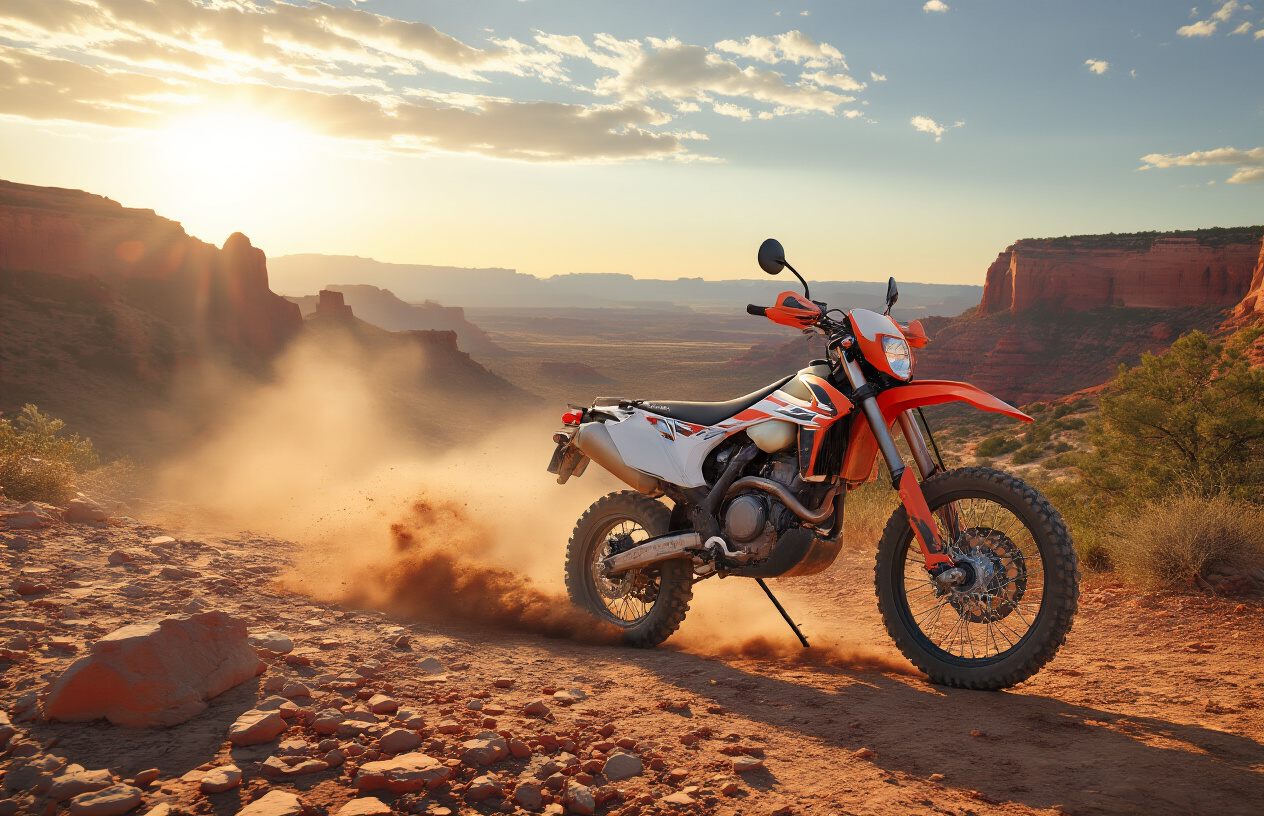
Dirt Bikes for Technical Trail Riding
Ever tried squeezing through narrow forest paths or bombing up steep, rocky inclines? That’s where proper dirt bikes shine. The Honda CRF450X remains the gold standard for American trail riding – lightweight at just 275 pounds but packing serious punch for those sudden uphill scrambles.
KTM’s 350 EXC-F deserves serious consideration too. It hits that sweet spot between the nimble 250s and the sometimes overwhelming 450s. Perfect for those Moab slickrock trails or Tennessee woodland routes where you need responsive handling.
Dual-Sports for Mixed On/Off-Road Use
You want one bike that does it all? A dual-sport is your answer.
The Yamaha WR250R has developed a cult following for good reason. It’s basically a dirt bike with just enough street-legal components to let you connect trail systems via public roads. The Suzuki DR-Z400S follows the same formula but with more grunt.
For something with modern tech, check out the KTM 690 Enduro R. Fuel injection, sophisticated suspension, and enough power to cruise highways comfortably before tackling serious off-road sections.
Adventure Bikes for Long-Distance Off-Road Touring
Planning a multi-day backcountry expedition? Adventure bikes are built for exactly that.
The BMW R1250GS Adventure dominates this category. It’s a beast at 600+ pounds fully loaded, but those electronically adjustable suspension settings make it surprisingly capable when the pavement ends.
For riders who find the GS intimidating, the KTM 890 Adventure R offers a more manageable package without sacrificing off-road capability. Its lower weight and rally-inspired design make it particularly good on the Continental Divide Route.
Honda’s Africa Twin deserves mention too – especially with its DCT automatic transmission option that’s a godsend in technical terrain when you’d rather focus on balance than shifting.
Regional Considerations: Bikes for Desert, Mountain, and Forest Riding
Different American landscapes demand different machines.
For desert riding across Nevada or Arizona, you need something with cooling systems that won’t quit in 100°F heat. The Husqvarna FE501 excels here with its oversized radiators and heat-resistant components.
Mountain trails in Colorado or Montana? The Beta 500 RR-S shines with its torquey power delivery that helps maintain traction on loose, steep climbs.
Tackling dense forests in the Pacific Northwest? The Gas Gas EC300 has the nimble handling and slim profile to navigate between trees while its two-stroke engine provides the instant punch needed to power over wet roots and logs.
Multi-Purpose Motorcycles: The Best of All Worlds
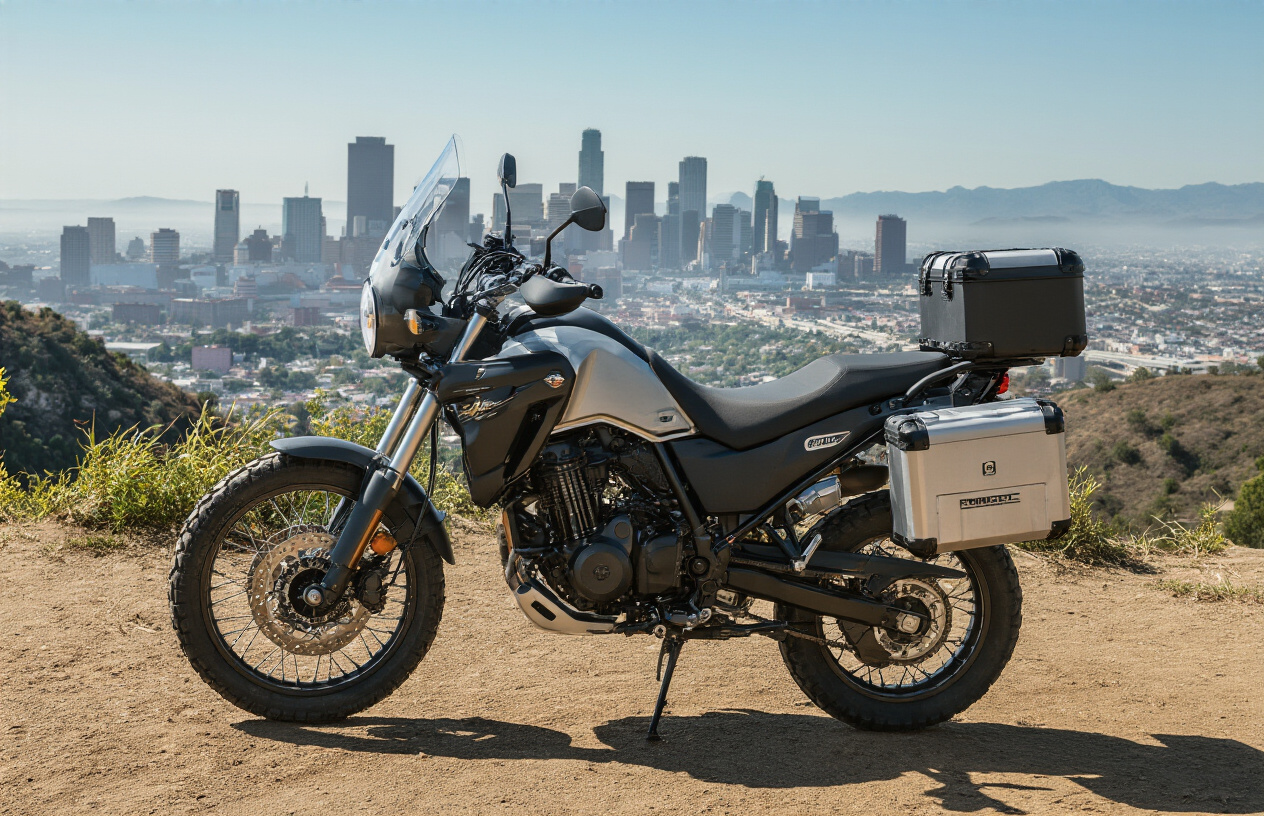
Adventure Motorcycles: Ultimate Versatility Champions
Ever noticed how some riders seem to have a different bike for every scenario? Not everyone has that luxury. Adventure bikes are the Swiss Army knives of motorcycles – they’ll take you across states on highways, navigate city traffic without drama, and handle dirt roads when the pavement ends.
Bikes like the BMW R1250GS and Triumph Tiger 900 have conquered everything from Starbucks parking lots to the Atacama Desert. They pack comfortable upright seating positions, wind protection for highway cruising, enough ground clearance for rough terrain, and luggage capacity that puts some cars to shame.
The secret sauce? These bikes blend the reliability of touring machines with the capability of dirt bikes. You get adjustable suspension, rider modes that change engine character with a button press, and frame geometry that works across environments.
Customization Options to Adapt One Bike for Multiple Uses
Your multi-purpose motorcycle becomes even more versatile with the right mods. Swapping tires makes a massive difference – stick with 80/20 road/dirt tires for mostly pavement riding or flip to knobby 50/50 tires when hitting trails becomes a priority.
Accessories transform functionality too:
- Adjustable windscreens (tall for highways, short/none for off-road)
- Luggage systems (hard cases for travel, soft bags for trails)
- Ergonomic adjustments (lowered footpegs for standing, heated grips for cold rides)
- Protection (crash bars, skid plates when terrain gets serious)
Compromises to Consider with Do-It-All Motorcycles
The jack-of-all-trades approach comes with tradeoffs. These bikes typically weigh more than dedicated dirt bikes, making tight technical trails challenging. They’re also bulkier than pure street machines, so filtering through traffic requires extra attention.
Maintenance costs run higher too. Those sophisticated electronics and complex suspension systems that enable versatility don’t come cheap when service time rolls around.
The biggest compromise might be psychological – these bikes do everything well but excel at nothing. A dedicated sport bike will always be faster on twisty roads; a proper dirt bike will float over obstacles that make adventure bikes struggle.
But that’s the deal: one bike that gets you 85% there in every scenario versus three perfect bikes gathering dust in your garage.
Essential Accessories for Versatile Riding
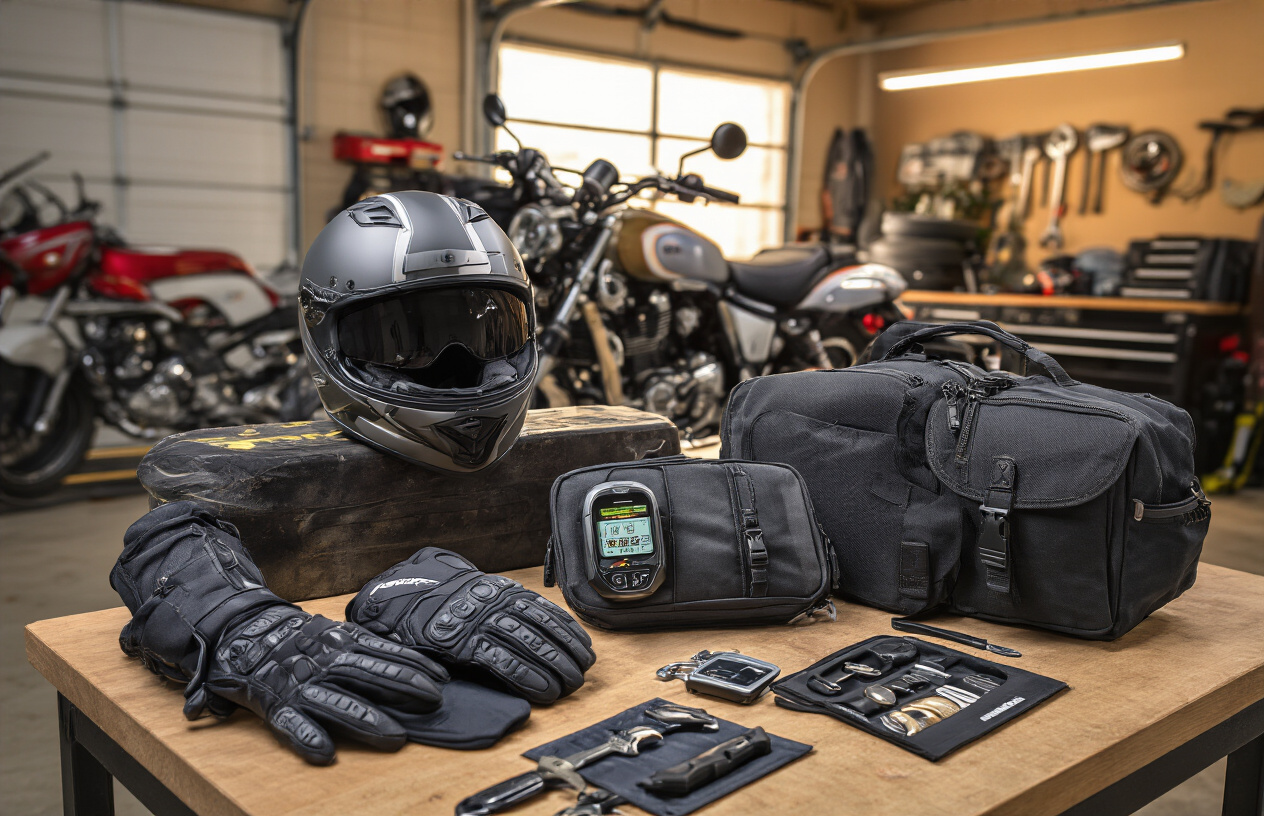
A. Storage Solutions for Different Riding Styles
Ever tried cramming a weekend’s worth of gear into a backpack while riding? Yeah, not fun. The right storage can make or break your motorcycle experience.
For touring riders, hard panniers are your best friends. They’re weatherproof, secure, and won’t flap around at highway speeds. Brands like Givi and SW-Motech offer aluminum options that can take a beating while protecting your stuff.
City riders need something different. A magnetic tank bag gives you quick access to essentials without dismounting. Or try a sleek tail bag that doesn’t scream “tourist” when you park.
Off-road enthusiasts, you need flexible, waterproof soft bags. They’ll forgive you when (not if) you drop your bike, unlike rigid cases that might snap or damage your bike’s frame.
B. Protection Gear for Various Environments
Riding through Death Valley in July isn’t the same as cruising Seattle in November. Duh.
Desert riders need mesh jackets with removable liners and hydration systems. The RevIt Sand 4 or Klim Badlands Pro are worth every penny when temperatures climb.
Urban warriors should look at armored hoodies and jeans from brands like Pando Moto or REV’IT! They offer protection without making you look like you’re headed to a track day.
Mountain and forest riders need waterproof, breathable gear with bright colors. The Klim Latitude or Rukka Navigatorr suit will keep you dry and visible when those clouds roll in unexpectedly.
C. Comfort Enhancements for Long Rides
Nobody enjoys numb hands and a sore butt after two hours on the road.
An aftermarket seat is the smartest upgrade for any serious rider. Companies like Corbin and Sargent make custom options that distribute pressure points better than stock seats ever could.
Handlebar risers can transform your riding position, especially on adventure bikes that sometimes feel like you’re reaching for the horizon.
Cruise control – whether factory or throttle lock like the Kaoko – saves your wrist on those endless interstate stretches.
And don’t overlook windscreens. The right height can eliminate that neck-straining buffeting that leaves you exhausted after a long day.
D. Tech Additions for Navigation and Communication
Getting lost might sound romantic until you’re running on fumes with no cell service.
A dedicated GPS like the Garmin Zumo XT offers glove-friendly controls and won’t die when your phone overheats in direct sunlight. Mount it high on your handlebars so you don’t take your eyes off the road.
Bluetooth communication systems from Cardo or Sena let you talk to riding buddies, take calls, or listen to directions without stopping. The Packtalk Bold has mesh networking that reconnects automatically when riders drop in and out of range.
USB ports aren’t just nice-to-have anymore – they’re essential. Get a RAM mount for your phone and wire in a charging system that connects to your battery.
Test Riding and Making the Final Decision
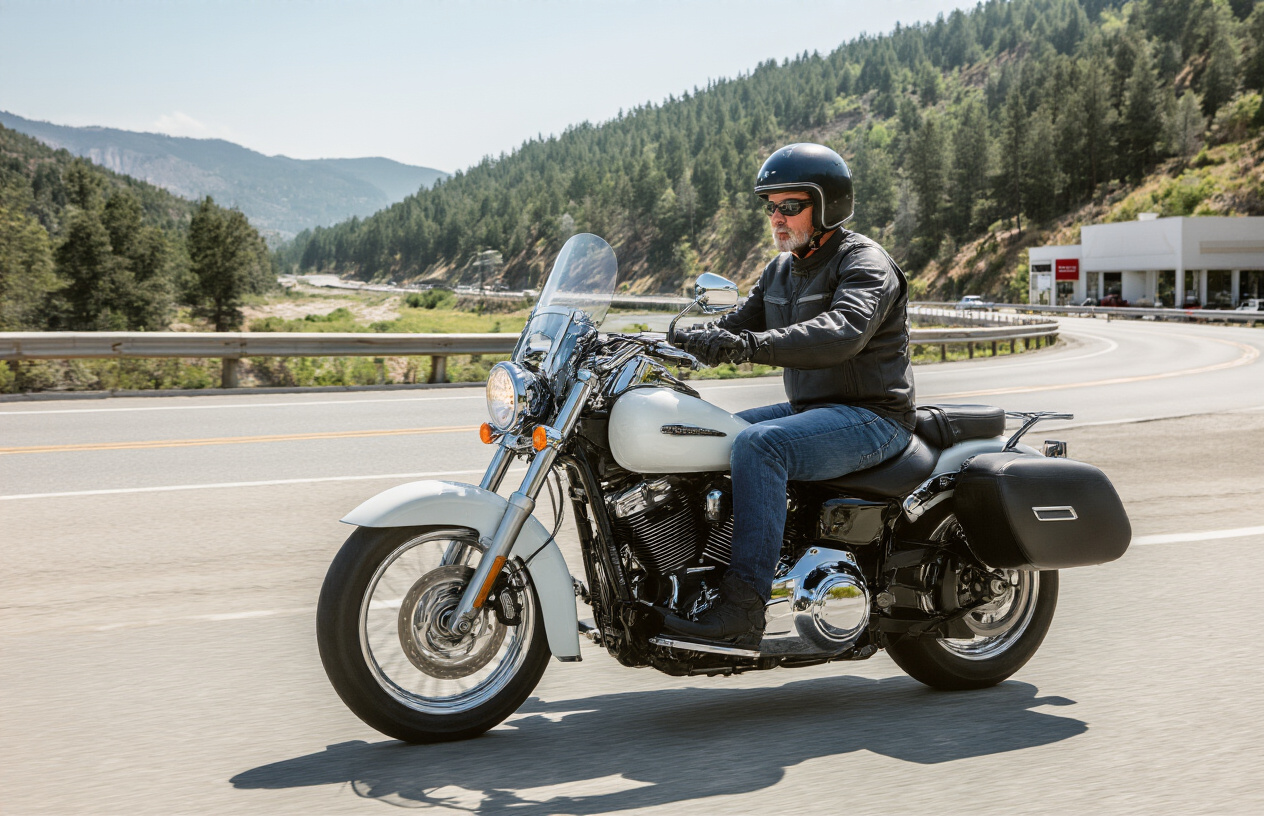
A. Where to Test Different Motorcycle Types
Dealerships are your obvious first stop, but they’re not the only game in town. Most major motorcycle brands have demo days where you can try multiple bikes in one place. It’s like speed dating, but with engines.
Motorcycle shows and rallies? Gold mines for test rides. You’ll find everything from cruisers to adventure bikes lined up and ready to go.
Don’t overlook rental places, especially for touring bikes. Dropping $50 for a day’s rental beats buying the wrong $15,000 bike every time.
For off-road options, check out dirt bike schools and adventure riding centers. They typically have fleets of bikes you can try while getting some training. Two birds, one stone.
B. What to Look for During Each Type of Test Ride
For touring bikes: Pay attention to your comfort after 30+ minutes. Is your back screaming? Are your wrists numb? That slight discomfort becomes torture at mile 200.
For city rides: Focus on low-speed handling and maneuverability. Can you easily filter through traffic? How’s the clutch in stop-and-go situations?
For off-road machines: Test the standing position. Your knees should bend slightly when standing on the pegs. See how the bike handles both loose dirt and rocky sections.
For all bikes, check these basics:
- Does it fit your height? (Both feet should touch the ground)
- Can you reach all controls comfortably?
- Is the weight manageable when pushing it around?
C. Comparing New vs. Used Options
| Factor | New | Used |
|---|---|---|
| Cost | Higher upfront | Lower initial investment |
| Warranty | Full coverage | Limited/none |
| Condition | Perfect | May need work |
| Depreciation | Immediate 15-20% | Already absorbed |
| Customization | Start fresh | May have upgrades |
The sweet spot? Two to three-year-old bikes. Previous owner ate the depreciation, but modern features are still there.
D. When to Consider Renting Instead of Buying
Renting makes perfect sense when:
- You’re only riding seasonally (think 2-3 months a year)
- Storage is an issue at your place
- You want different bikes for different trips (cruiser for Route 66, adventure bike for Colorado)
- You’re not sure if motorcycling is for you
Monthly subscriptions like EagleRider’s Club or Twisted Road give you access to various bikes without the commitment.
The brutal truth? If you’re riding less than 20 days a year, ownership probably isn’t worth it financially. Rent when you need it instead.
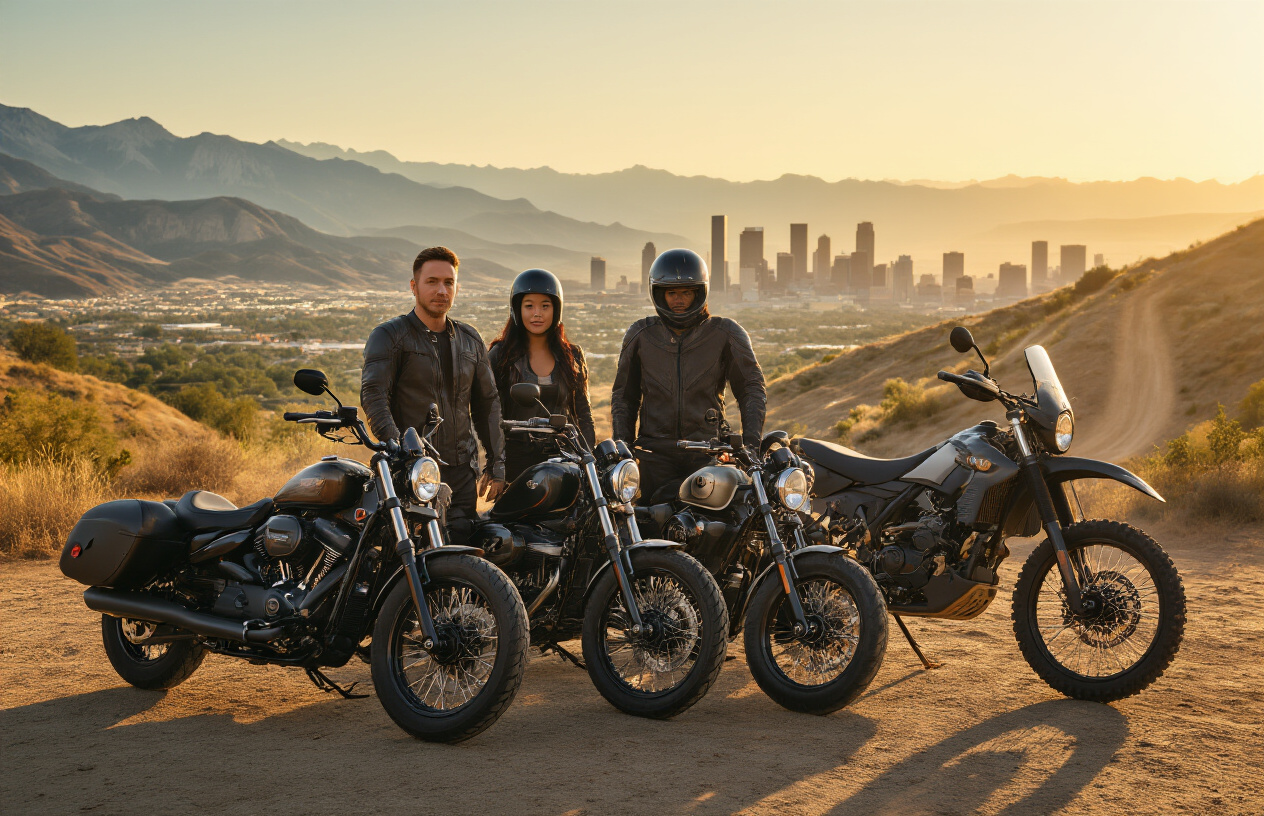
Selecting the perfect motorcycle requires carefully balancing your riding preferences with practical considerations. Whether you’re cruising America’s open highways on a comfortable touring bike, navigating busy urban streets on a nimble city motorcycle, or tackling rugged trails on a capable off-road machine, this guide has highlighted the key factors to weigh in your decision. From engine size and ergonomics to maintenance requirements and budget constraints, understanding these elements ensures you’ll find a motorcycle that matches your specific needs.
Remember that test riding is crucial before making your final choice. Take time to experience how different motorcycles handle in their intended environments, and don’t overlook the value of versatile, multi-purpose options if you enjoy varied riding styles. With the right motorcycle and essential accessories, you’ll be well-equipped to enjoy everything American roads have to offer—from coast-to-coast adventures to daily commutes and weekend trail explorations. Your perfect ride is waiting!

